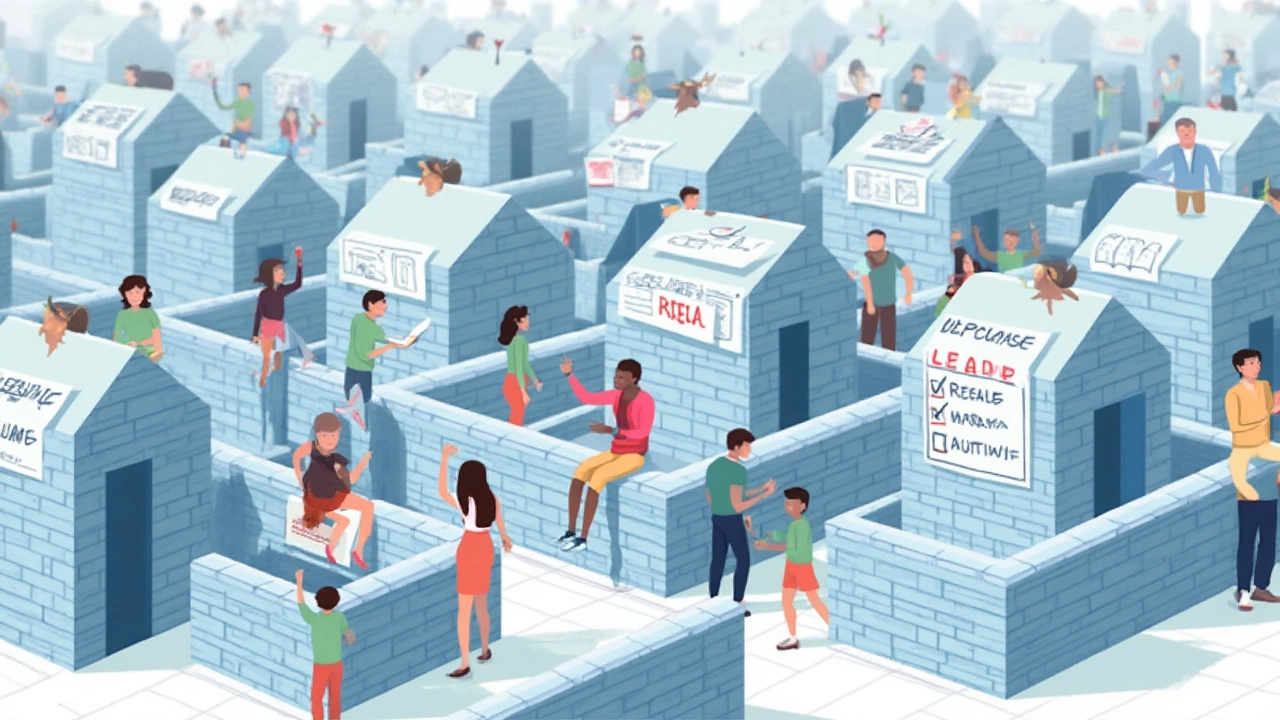Cons of Shared Ownership Homes: What You Need to Know About Buying Shares
 Apr, 26 2025
Apr, 26 2025
Shared ownership homes sound like a shortcut to owning your place, but there’s a lot they don’t tell you in the glossy brochures. Sure, you buy a percentage and pay rent on the rest—cheaper than buying outright, right? Well, not always. The mix of mortgage plus rent plus service charges can add up fast. Suddenly, what seemed affordable looks a whole lot less exciting when every monthly bill lands.
One thing that catches many people off guard: those fees go up. Inflation, building maintenance, weird little charges buried in your contract—your wallet feels every pound. Don’t let the “low entry cost” headline fool you. That’s just the ticket in. The ride gets pricier as you go.
- Hidden Costs and Monthly Fees
- Limited Control and Restrictions
- Challenges of Selling Your Share
- Long-Term Financial Impact
Hidden Costs and Monthly Fees
Here’s the thing about shared ownership: your monthly costs don’t just cover your mortgage. You’ve got to budget for rent on the share you don’t own. Each year, that rent usually creeps up with inflation—typically 3% or RPI (Retail Price Index) plus 0.5%, whichever is higher. So, your expenses can easily outpace your wage increases if you’re not careful.
But wait, there’s more. Most homes in a shared ownership scheme come with mandatory service charges and ground rent. Sometimes, these feel buried in the fine print. You might get hit with bills for everything from hallways being cleaned to garden upkeep—even if you hardly use those areas. In a lot of newer developments, annual service charges can reach £1,500 or more, and they rarely go down.
You also need to think about repair costs. Unlike traditional renting, you’re on the hook for all repairs inside your flat from the start, even if you only own a 25% share. Some housing associations—like Clarion or L&Q—have added “sinking fund” charges for future big repairs, and they aren’t always clear about the timing.
- Mortgage payments: For your share only, but rates vary.
- Rent payments: On the rest, often increasing yearly.
- Service charges: Maintenance, cleaning, usually non-negotiable and rising.
- Ground rent: Another ongoing cost, sometimes up to £200–£400 a year.
- Repair bills: All yours from the day you move in.
Tip: Always ask for a full breakdown of all monthly and yearly costs before you commit. If you skip this step, you might sign up for way more than you bargained for.
| Cost Type | Average Annual Cost (£) | How Often It Rises |
|---|---|---|
| Service Charges | 1,500–3,000 | Yearly (inflation or maintenance) |
| Rent on Unowned Share | 4,000–8,000 | Yearly (RPI + x%) |
| Ground Rent | 200–400 | Set by contract, can rise |
| Repairs | Varies | As needed |
If you're weighing up shared ownership, plug every cost into your budget—even the ones that seem small. Surprises with money are the last thing you need once you’ve moved in.
Limited Control and Restrictions
Shared ownership might seem like a step toward independence, but you actually give up a lot of say in your own home. The shared ownership scheme means you’re part-owner and part-tenant, so you have to follow your housing association’s rules. Decor choices, renovations, even getting a new pet—all of these can require written permission. Want to knock down a wall or redo the kitchen? You’ll have to ask first, and sometimes the answer’s just “no.”
You can’t decide who fixes things, either. All repairs for communal areas (like hallways or the roof) are out of your control, and you’ll still pay your share—even if the work doesn’t suit you. Private fixes inside your flat or house? Double-check your lease: some jobs, like rewiring or big plumbing changes, are off-limits unless approved.
Thinking about subletting? Most shared ownership agreements don’t let you rent out your place, not even a room. It doesn’t matter if you’re away for a few months or just want to help with bills. You could lose your home if you break that rule. Even swapping or assigning your share to a partner or family member gets complicated and usually needs formal approval.
Here’s a quick look at some restrictions that catch buyers by surprise:
- Pets—Often need written approval, sometimes not allowed at all
- Major home upgrades—Must be approved in writing by the housing provider
- Subletting—Almost always forbidden
- Running a business from home—Usually not allowed
- Choice of contractor for repairs—Limited to approved providers
According to a 2023 survey by Shared Ownership Resources, 62% of shared homeowners felt they had less freedom at home than they expected. For most people, it’s a shock to realize they can’t treat their flat or house like a fully owned property. If you value doing things your own way, these shared homes rules can get old, fast.

Challenges of Selling Your Share
If you think selling a shared ownership home is as easy as selling a regular place, you’re in for a surprise. This is one part of the deal most buyers wish they knew more about before signing up. Unlike standard house sales, you can’t just stick up a “For Sale” sign and take the first decent offer.
Most housing associations have what’s called a “nomination period.” This means, for the first 8 to 12 weeks (sometimes longer), you can only sell your share to people on their waiting list—basically, they get first dibs. Even if you know someone who wants to buy, you’re stuck waiting for the association to try their own matches first.
And here’s where things can drag. Some folks end up waiting months for a buyer to bite, especially if your share is in an area where demand is low. According to data from Share to Buy, over 65% of shared owners took longer than three months to sell their share in 2023.
| Average Wait to Sell | Percentage of Owners |
|---|---|
| Under 3 months | 35% |
| Over 3 months | 65% |
Even if you do get an offer, there are extra steps and legal fees. You’ll need to get a formal valuation—sometimes more than once if it expires—and your buyer must qualify for the shared ownership scheme. Every round of paperwork increases the wait and pushes your moving date further out.
"Selling a shared ownership property can be much slower and more complicated than selling a full-ownership home, especially if there are a lot of rules and restrictions."
— MoneySavingExpert.com
One last headache: if you “staircased” (bought extra shares over time), you still have to work within the same rules. And in some cases, shared owners have to pay for repairs or upgrades before they can even list their share, which can cost more time and money.
If you’re after quick, hassle-free selling later on, shared ownership homes aren’t known for it. The selling process is full of caveats and waiting games, so weigh this carefully before jumping in.
Long-Term Financial Impact
Buying a place through shared ownership might seem like a smart move to get on the property ladder, but the numbers can pile up in ways you don’t expect. Let’s break down what really happens to your money over time—you might be surprised at how things shift after the first few years.
First off, when you own only part of the home, you’re usually paying rent on the remaining share. This rent typically goes up every year. Most housing associations bump it by the Retail Price Index (RPI) plus another chunk—usually 0.5-2%. That’s a lot more than your standard inflation. Over ten years, it can mean your rent’s jumped way more than you’d budget for.
- You pay full maintenance and service charges, not just for the share you own but for the entire property.
- Mortgage payments do not shrink as your ownership share stays the same (unless you 'staircase,' which means buying more of the home, but that involves extra fees and valuation costs each time).
- Staircasing often gets more expensive as home values rise, making it harder to ever own 100%.
Another thing—building up equity is slower. As property prices rise, so does the price for each new slice of ownership you want to buy. Back in 2023, average UK property prices rose 5%, but shared owners found that buying an extra 10% of their home sometimes cost much more than expected, with fees and updated valuations biting into the budget.
| Expense Type | Standard Homeowner | Shared Ownership |
|---|---|---|
| Initial deposit | 10-20% of property price | 5-10% of share price |
| Yearly rent increase | None | RPI + 0.5-2% |
| Staircasing costs (per increase) | Not needed | £1,500 - £3,000 avg (2023) |
| Service charges | Applies | Applies (often higher) |
And when it’s time to sell? You can only sell your share, unless you’ve bought the place outright. Housing associations usually have first dibs on finding a buyer, which can take longer and sometimes means you get less money than you expected.
If you want genuine financial freedom, shared ownership can end up locking you into a long-term deal with more strings attached than most people realize. Always check the numbers, read the small print, and ask for a full list of future costs before you sign anything. Buying shares in a home is not always the bargain it looks like on the surface.